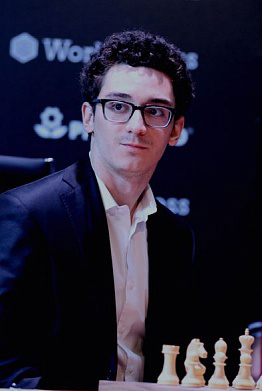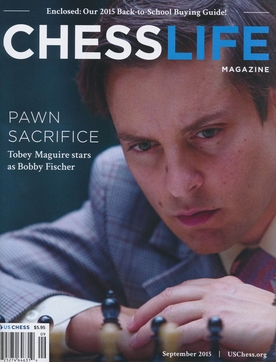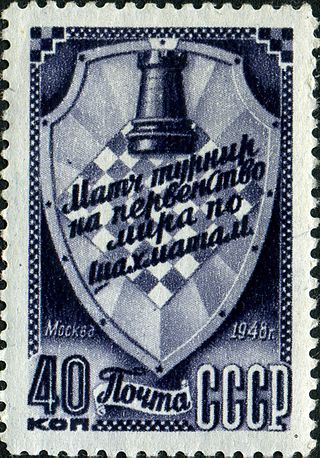
Alexander Aleksandrovich Alekhine was a Russian and French chess player and the fourth World Chess Champion, a title he held for two reigns.

José Raúl Capablanca y Graupera was a Cuban chess player who was the third world chess champion from 1921 to 1927. A chess prodigy, he is widely renowned for his exceptional endgame skill and speed of play.

The US Chess Championship is an invitational tournament organized by the United States Chess Federation to determine the country's chess champion. It is the oldest national chess tournament. The event originated as a challenge match in 1845, but the champion has been decided by tournament play under the auspices of the USCF since 1936. The tournament has fluctuated between a round-robin tournament and a Swiss system. From 1999 to 2006, the championship was sponsored and organized by the Seattle Chess Foundation and featured a larger body of competitors, made possible by the change to a Swiss-style format. After the Foundation withdrew its sponsorship, the 2007 and 2008 events were held in Stillwater, Oklahoma, still as a Swiss system, under tournament director Frank K. Berry. Rex Sinquefield's Saint Louis Chess Club has hosted the championship since 2009. Since 2014, the championship has used a round-robin format.

Reuben C. Fine was an American chess player, psychologist, university professor, and author of many books on both chess and psychology. He was one of the strongest chess players in the world from the mid-1930s until his retirement from chess in 1951. He was granted the title of International Grandmaster by FIDE in 1950, when titles were introduced.
The zwischenzug is a chess tactic in which a player, instead of playing the expected move, first interposes another move posing an immediate threat that the opponent must answer, and only then plays the expected move. It is a move that has a high degree of "initiative". Ideally, the zwischenzug changes the situation to the player's advantage, such as by gaining material or avoiding what would otherwise be a strong continuation for the opponent.

Irving Chernev was a chess player and prolific Ukrainian-born American chess author. He was born in Pryluky, Ukraine, then a part of the Russian Empire and emigrated to the United States in 1905. Chernev was a national master-strength player and was devoted to chess. He wrote that he "probably read more about chess, and played more games than any man in history."
Fred Reinfeld was an American writer on chess and many other subjects. He was also a strong chess master, often among the top ten American players from the early 1930s to the early 1940s, as well as a college chess instructor.

Israel Albert Horowitz was an American International Master of chess. He is most remembered today for the books he wrote about chess. In 1989 he was inducted into the US Chess Hall of Fame.

British Chess Magazine is the world's oldest chess journal in continuous publication. First published in January 1881, it has appeared at monthly intervals ever since. It is frequently known in the chess world as BCM.

The monthly Chess Life and bi-monthly Chess Life Kids are the official magazines published by the United States Chess Federation. Chess Life is advertised as the "most widely read chess magazine in the world", and reaches more than a quarter of a million readers each month. It focuses on American chess players and tournaments, instruction, human interest, and US Chess governance matters. Chess Life Kids is geared towards those under 14. A subscription to Chess Life and Chess Life Kids is currently one benefit of becoming a US Chess member or affiliate. All members are given access to the online versions of Chess Life and Chess Life Kids. Affiliates and some membership categories also receive printed copies of Chess Life and/or Chess Life Kids.

Isaac Kashdan was an American chess grandmaster and chess writer. He was twice U.S. Open champion. He played five times for the United States in chess Olympiads, winning a total of nine medals, and his Olympiad record is the all-time best among American players.

The 1948 World Chess Championship was a quintuple round-robin tournament played to determine the new World Chess Champion following the death of the previous champion Alexander Alekhine in 1946. The tournament marked the passing of control of the championship title to FIDE, the International Chess Federation which had been formed in 1924. Mikhail Botvinnik won the five-player championship tournament, beginning the era of Soviet domination of international chess that would last over twenty years without interruption.

Napoleon Marache was a chess player, problem composer, and journalist. He was born in France and moved to the United States at around 12 years of age. He learned the game of chess around 1844, and immediately became a devotee. He began composing chess problems and writing about chess the following year. In the mid-19th century, he was both one of America's first chess journalists and one of its leading players. In 1866, he published Marache's Manual of Chess, which was one of the country's first books on chess, and also one of its first books on backgammon. He is perhaps best known today for having lost a famous game to Paul Morphy.
Below is a list of events in chess in the year 1941.
The below is a list of events in chess in 1939.
Zürich 1934 was an international chess tournament held in Zürich from 14 to 29 July 1934 to commemorate the 125th anniversary of Schachgesellschaft Zürich. Alexander Alekhine won, followed by Max Euwe and Salo Flohr tied for second-third. The tournament also served as the 1934 Swiss Championship, won by Hans Johner as the highest-ranking Swiss player.
The 1948 Interzonal tournament was a major qualification event for the 1951 World Chess Championship, held in Saltsjöbaden, Sweden from 16 July to 14 August in 1948. It was the first Interzonal tournament organised by FIDE, which was at the time emerging as the game's international governing body. The 20 player round robin tournament was won by David Bronstein, who along with seven other players advanced to the 1950 Candidates Tournament.











